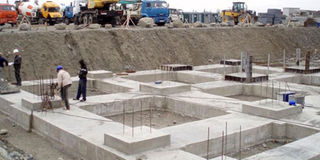Avoid foundation defects

What you need to know:
- A raft kind of foundation, Atwine says is usually good for storeyed buildings.
- There are a number of ways, some of which are mechanical, that can easily be applied to avoid any kind of foundation defects.
Foundation defects can be as costly as they are inconveniencing. Its failure can cause many defects in the building including failure or collapse of the building. Repairing defects such as cracks in foundations are most difficult and very costly, so it is important to be careful before construction starts.
Luis Pius Chelimo, a structural engineer with Trinity Technical Services Limited, reveals that there are many reasons why a foundation cracks but most of them are a result of poor construction or poor design.
“Problems such as cracks and leaks that may come as a result of a poor foundation are easily preventable.
“Before construction commences, the contracting engineer should carry out a study of the site and compile a geotechnical report of their findings,” Chelimo says. The main importance of the report is the evaluation of the mechanical strength of the ground where the house is going to be built.
Without this evaluation, Chelimo says there will be poor or insufficient ground preparation and consequently affecting the foundation. “Some people usually rush to build without doing some of these things which is dangerous since we are gambling on the strength of the ground,” he adds.
Ronald Atwine, an engineer with Excite Construction Limited Uganda, explains that this test is what is generally known as the California Bearing Ratio (CBR) and is usually done in a laboratory by a professional geotechnical engineer.
“Most people who are employed to do this kind of job are actually not well trained which is a challenge in itself and may bring about foundation defects since they give results that are not actual,” Atwine says.
Types of foundation
Atwine says that there are three major types of foundation which include strip, pile and raft foundation. “Each of these foundations is suitable for different types of soils. Strip is suitable for sandy and clay soils. Because the water table is high, a depth of 700mm is recommended as long as the ground has adequate bearing capacity,” he adds.
A raft kind of foundation, Atwine says is usually good for storeyed buildings.
“Because the foundation area is large bearing it becomes more economical to pour one large reinforced concrete slab,” he explains.
A pile foundation as the name suggests is where a series of columns (piles) can be bored and cast or precast piles driven into place until they reach stronger strata. It is suitable where the ground conditions will not support strip foundations and the depth of trench fill foundations become too expensive, or ground conditions make them unsuitable.
Solutions
There are a number of ways, some of which are mechanical, that can easily be applied to avoid any kind of foundation defects.
• The underpinning method according to Atwine is one of them. “This method is done when the affected part is excavated to help solve this problem,” he says.
•He however, says that this kind of method usually needs good expertise for it to be effective.
•Chelimo emphasises that carrying out a structural analysis is important before building is done. This, he says, helps know when, where and how to build a structure.




